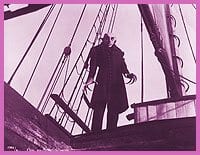FW Murnau is one of those legendary masters of silent film whose work remains fresh throughout the years. Toronto audiences will have a chance to see a dozen of his films, both classics and rarities, at the Cinematheque beginning Fri, Feb 11.
Almost always described as the supreme cinematic poet, Murnau’s films such as Sunrise, Faust, Nosferatu, City Girl, The Last Laugh and Tabu are known for their graceful, fluid moving camera shots, their painterly, atmospheric sculpting of light and shadow and a highly composed sense of depth to the screen space. He produced some of the most startling, strange, affecting and memorable images in film history through what appear to be some of the most archetypal, mythic narratives: good versus evil, the threat that desire and primal emotions pose to civilization and moral uprightness.
Murnau’s stylistic eccentricities are widely acknowledged – you know you’re in for a treat when stuffy old documentarian John Grierson tongue-lashed him for artifice, perversity and exaggeration. But what has been debated for at least 30 years is the role of Murnau’s queerness. Like that other great silent-era queer director, the Soviet Sergei Eisenstein, there have been clashes over how much significance to give the sexuality of a director working 80 years ago. Is it really productive to interpret every Murnau film as a struggle between queer desire and Germanic repression?
Cinematheque’s senior programmer James Quandt contributes to the debate in his essay in the current program guide. He faults Murnau critic Jean-Andre Fieschi for decrying the “oversights, evasions and clichés” of other Murnau commentators while at the same time dancing around the topic of the director’s homosexuality. In contrast, Quandt finds traces of Murnau’s queerness in the way he directs our attention to every detail of the space within the film frame, crafting an unstable, idiosyncratic, “obscure” world that evokes “uncertainty and apprehension, ambiguity and foreboding.”
Before Quandt, critics Tom Waugh and Robin Wood also questioned how the violence of institutionalized homophobia manifested itself in Murnau’s films. Waugh’s “Murnau: The Films Behind The Man” was originally written for The Body Politic (Xtra’s predecessor) in 1979. The essay sought to deflate the persistent myth of the tormented homo-sexual artist that focusses on romantic stereotypes at the expense of a specific understanding of his life and work. Waugh criticized biographer and grande doyenne of film history Lotte Eisner for using code words like “sensitivity,” “delicacy” and “sentimentality,” concluding, “Eisner’s sentimental absorption in Murnau’s alienation, in his longing for beauty, exile and death, ultimately implies that those qualities are aspects of some universal homosexual sensibility rather than functions of a specific personality dominated by a specific historical context.”
Wood proposed that many of Murnau’s films follow the same revealing narrative pattern: a heterosexual couple’s union is threatened by the invasion of a sinister outsider who is much more compelling and dynamic than the protagonists – whether grotesque vampire in Nosferatu, feline vamp in Sunrise or naughty Satan himself in Faust. (Waugh sees Murnau’s plain Janes and nelly heroes – the young Faust is one of the softest leading men ever on screen – as more gender deviant than most stars at the time). Wood sees a deep level of self-oppression in Murnau’s deification of the “redemptive power” of the heterosexual couple against temptation, the “wish-fulfillment fantasy” of a tragic homo. In the justly celebrated Sunrise (screening at 8:15pm on Fri, Feb 11), for example, the power of the couple is represented in the finale by a sun that seems to “annihilate” sinful woman from the city.
Wood also provided a queer reading of Nosferatu (6:30pm, Tue, Feb 15), an illicit adaptation of Bram Stoker’s Dracula, featuring an unforgettable demon who spreads contagion – a phobic metaphor for queer or Jew or Asian depending on what film studies thesis you’re reading – who represents unrepressed desire and difference. For Wood, he’s a “dark, terrible” aspect of the natural world whose doom and destruction will be unleashed on our prim, tidy civilization. As in Faust and many of his other films, the wild stylization – superimpositions, fast motion, expressionist lighting and audacious costumes, set design and makeup – is outstanding for its modern feel and the genuine creepiness it produces.
Tabu (6:30pm, Thu, Mar 3) is Murnau’s last film, and it is widely considered to be his gayest. Politically incorrect orientalism has never been so homoerotic as in this coproduction with pioneering documentarian Robert Flaherty (Nanook Of The North) set in the “exotic” South Seas. Wood and Waugh have both suggested that the sensual Tabu – about Bora-Bora lovers on the lam – reverses the ideology behind the earlier films. Here eros is harmonious with life, individual desire is good and tribal tradition and community responsibility gets in the way of its expression.
My personal favourite Murnau film is The Last Laugh (6:30pm, Feb 11), for the pioneering use of a moving camera (which exhibits a freedom unparalleled in 1924), for its use of the camera to illustrate both the point-of-view and the thoughts of its protagonist, and for the hugely overstated gestural acting of the portly Emil Jannings (who also plays the clownish Mephisto in Faust). Here Jannings stars as the proud, aging doorman at a fancy hotel whose life spirals into miserable indignity when he is demoted to bathroom attendant and loses the precious uniform that brought him his local prestige. One of the great – and there are many – portraits of humiliation in the silent cinema, and the most moving film by an effete gay artist living under Germany’s anti-homo Paragraph 175.
CINEMATHEQUE.
$10.10 for nonmembers.
Jackman Hall.
317 Dundas St W.
(416) 968-FILM.
Bell.ca/cinematheque.


 Why you can trust Xtra
Why you can trust Xtra


